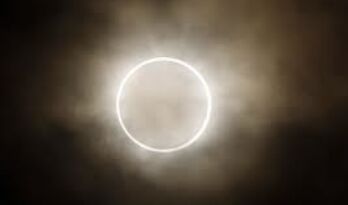Get Ready! Rare 'Ring of Fire' Eclipse to Dazzle Americas in 2023
Rare Annular Solar Eclipse to Create Ring of Fire in the Skies: Millions of people in the Americas will have a unique chance to witness and study this captivating celestial event.
An annular solar eclipse will take place on October 14, 2023, creating a captivating ring of fire in the skies over North, Central, and South America. This rare celestial event will offer a unique viewing experience for millions of people and present an exceptional opportunity for scientific study. During the annular solar eclipse, the moon will pass in front of the sun, but due to its position in its orbit, it will not completely block the sun.
On 14 October, up to 91 per cent of the sun will be blocked, leaving a bright “ring of fire” visible for up to five minutes from inside a 125-mile-wide path through nine US states. This is called an annular eclipse.
— New Scientist (@newscientist) October 3, 2023
Instead, a ring of fiery sunlight will surround the moon's shadow, hence the nickname "ring of fire." Peg Luce, the acting director of the Heliophysics Division at NASA headquarters, describes this phenomenon as a display of "awe and wonder." The eclipse will begin in the United States at 9:13 a.m. PT and pass through several states including Oregon, Nevada, Utah, New Mexico, and Texas. Parts of California, Idaho, Colorado, and Arizona will also get a glimpse of the lunar shadow. The eclipse will then continue its path through Mexico, Belize, Honduras, Panama, and Colombia before ending in Natal, Brazil, off the Atlantic coast of South America.
If weather conditions permit, residents in all 49 continental US states, including Alaska, will be able to witness a crescent-shaped partial solar eclipse. To find out when and where the eclipse will be visible, NASA provides an interactive eclipse map. Those eager to witness the eclipse but unable to see it in person can still join in through NASA's live stream, which will begin at 11:30 a.m. ET on eclipse day. The live stream will showcase views from Albuquerque, New Mexico, Kirbyville, Texas, and White Sands, New Mexico. The importance of observing the eclipse safely cannot be overstated.
Looking directly at the sun without proper protection can cause severe eye damage. For safe viewing, it is vital to wear certified eclipse glasses or use a handheld solar viewer. Regular sunglasses will not provide adequate protection. Additionally, using specialized filters on cameras, telescopes, or binoculars is crucial to prevent solar rays from causing damage. The upcoming annular solar eclipse holds particular significance, as the next opportunity to witness this phenomenon in the same part of the country will not occur until 2046. Scientists are eager to make the most of this rare occurrence to conduct research.
During the eclipse, NASA will launch three sounding rockets to monitor how the drop in sunlight affects Earth's upper atmosphere, specifically the ionosphere. Amateur radio operators will also partake in an experiment to observe changes in radio wave travel during the eclipse. Preparing for the upcoming annular solar eclipse offers a chance for people to marvel at the wonders of the universe while prioritizing safety. It is a unique opportunity to witness a spectacle that brings together the Sun, Moon, and Earth in a mesmerizing display of celestial alignment.




